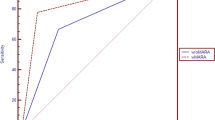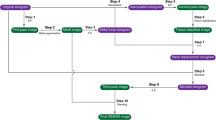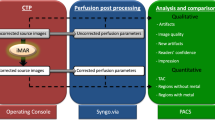Abstract
Objectives
Metal artefacts can impair accurate diagnosis of haemorrhage using flat detector CT (FD-CT), especially after aneurysm coiling. Within this work we evaluate a prototype metal artefact reduction algorithm by comparison of the artefact-reduced and the non-artefact-reduced FD-CT images to pre-treatment FD-CT and multi-slice CT images.
Methods
Twenty-five patients with acute aneurysmal subarachnoid haemorrhage (SAH) were selected retrospectively. FD-CT and multi-slice CT before endovascular treatment as well as FD-CT data sets after treatment were available for all patients. The algorithm was applied to post-treatment FD-CT. The effect of the algorithm was evaluated utilizing the pre-post concordance of a modified Fisher score, a subjective image quality assessment, the range of the Hounsfield units within three ROIs, and the pre-post slice-wise Pearson correlation.
Results
The pre-post concordance of the modified Fisher score, the subjective image quality, and the pre-post correlation of the ranges of the Hounsfield units were significantly higher for artefact-reduced than for non-artefact-reduced images. Within the metal-affected slices, the pre-post slice-wise Pearson correlation coefficient was higher for artefact-reduced than for non-artefact-reduced images.
Conclusion
The overall diagnostic quality of the artefact-reduced images was improved and reached the level of the pre-interventional FD-CT images. The metal-unaffected parts of the image were not modified.
Key Points
• After coiling subarachnoid haemorrhage, metal artefacts seriously reduce FD-CT image quality.
• This new metal artefact reduction algorithm is feasible for flat-detector CT.
• After coiling, MAR is necessary for diagnostic quality of affected slices.
• Slice-wise Pearson correlation is introduced to evaluate improvement of MAR in future studies.
• Metal-unaffected parts of image are not modified by this MAR algorithm.





Similar content being viewed by others
Abbreviations
- FD-CT:
-
Flat-detector CT
- MAR:
-
Metal artefact reduction
- MSCT:
-
Multi-slice CT
- HU:
-
Hounsfield units
References
Kalender WA, Kyriakou Y (2007) Flat-detector computed tomography (FD-CT). Eur Radiol 17:2767–2779
Struffert T, Eyupoglu IY, Huttner HB et al (2010) Clinical evaluation of flat-panel detector compared with multislice computed tomography in 65 patients with acute intracranial hemorrhage: initial results. Clinical article. J Neurosurg 113:901–907
Struffert T, Richter G, Engelhorn T et al (2009) Visualisation of intracerebral haemorrhage with flat-detector CT compared to multislice CT: results in 44 cases. Eur Radiol 19:619–625
Connolly ES, Rabinstein AA, Carhuapoma JR et al (2012) Guidelines for the management of aneurysmal subarachnoid hemorrhage: a guideline for healthcare professionals from the American Heart Association/american Stroke Association. Stroke 43:1711–1737
Struffert T, Ott S, Adamek E et al (2011) Flat-detector computed tomography in the assessment of intracranial stents: comparison with multi detector CT and conventional angiography in a new animal model. Eur Radiol 21:1779–1787
Engelhorn T, Struffert T, Richter G et al (2008) Flat panel detector angiographic CT in the management of aneurysmal rupture during coil embolization. AJNR Am J Neuroradiol 29:1581–1584
Heran NS, Song JK, Namba K et al (2006) The utility of DynaCT in neuroendovascular procedures. AJNR Am J Neuroradiol 27:330–332
Müller J, Buzug TM (2009) Spurious structures created by interpolation-based CT metal artifact reduction. In: Proceedings SPIE Medical Imaging. International Society for Optics and Photonics 7258, Medical Imaging 2009: Physics of Medical Imaging, p 72581Y–72581Y (March 13, 2009). doi:10.1117/12.813515
Prell D, Kyriakou Y, Beister M, Kalender WA (2009) A novel forward projection-based metal artifact reduction method for flat-detector computed tomography. Phys Med Biol 54:6575–6591
Prell D, Kyriakou Y, Struffert T et al (2010) Metal artifact reduction for clipping and coiling in interventional C-arm CT. AJNR Am J Neuroradiol 31:634–639
Yasuda M, Yoshikawa K, Kato K et al (2014) Validation of a metal artifact reduction algorithm using 1D linear interpolation for cone beam CT after endovascular coiling therapy for cerebral aneurysms. Neuroradiol J 27:742–754
Stidd DA, Theessen H, Deng Y et al (2014) Evaluation of a metal artifacts reduction algorithm applied to postinterventional flat panel detector CT imaging. AJNR Am J Neuroradiol 35:2164–2169
Meyer E, Raupach R, Lell M et al (2010) Normalized metal artifact reduction (NMAR) in computed tomography. Med Phys 37:5482–5493
Psychogios M-N, Scholz B, Rohkohl C et al (2013) Impact of a new metal artefact reduction algorithm in the noninvasive follow-up of intracranial clips, coils, and stents with flat-panel angiographic CTA: initial results. Neuroradiology 55:813–818
Doelken M, Struffert T, Richter G et al (2008) Flat-panel detector volumetric CT for visualization of subarachnoid hemorrhage and ventricles: preliminary results compared to conventional CT. Neuroradiology 50:517–523
Fisher CM, Kistler JP, Davis JM (1980) Relation of cerebral vasospasm to subarachnoid hemorrhage visualized by computerized tomographic scanning. Neurosurgery 6:1–9
Hung S-C, Wu C-C, Lin C-J et al (2014) Artifact reduction of different metallic implants in flat detector C-arm CT. AJNR Am J Neuroradiol 35:1288–1292
Jenkinson M, Bannister P, Brady M, Smith S (2002) Improved optimization for the robust and accurate linear registration and motion correction of brain images. NeuroImage 17:825–841
Jenkinson M, Smith S (2001) A global optimisation method for robust affine registration of brain images. Med Image Anal 5:143–156
Arnold JB, Liow JS, Schaper KA et al (2001) Qualitative and quantitative evaluation of six algorithms for correcting intensity nonuniformity effects. NeuroImage 13:931–943
Nawaz S, Fu J, Fan D (2014) Metal artifacts reduction in x-ray CT based on segmentation and forward-projection. Biomed Mater Eng 24:3287–3293
Andersson KM, Ahnesjö A, Vallhagen Dahlgren C (2014) Evaluation of a metal artifact reduction algorithm in CT studies used for proton radiotherapy treatment planning. J Appl Clin Med Phys 15:4857
Brook OR, Gourtsoyianni S, Brook A et al (2012) Spectral CT with metal artifacts reduction software for improvement of tumor visibility in the vicinity of gold fiducial markers. Radiology 263:696–705
Sennst D-A, Kachelriess M, Leidecker C et al (2004) An extensible software-based platform for reconstruction and evaluation of CT images. Radiographics 24:601–613
Prell D, Kalender WA, Kyriakou Y (2010) Development, implementation and evaluation of a dedicated metal artefact reduction method for interventional flat-detector CT. Br J Radiol 83:1052–1062
Buhk J-H, Groth M, Sehner S et al (2013) Application of a novel metal artifact correction algorithm in flat-panel CT after coil embolization of brain aneurysms: intraindividual comparison. RoFo 185:824–829
van der Bom IMJ, Hou SY, Puri AS et al (2013) Reduction of coil mass artifacts in high-resolution flat detector conebeam CT of cerebral stent-assisted coiling. AJNR Am J Neuroradiol 34:2163–2170
Filli L, Marcon M, Scholz B et al (2014) Evaluation of a prototype correction algorithm to reduce metal artefacts in flat detector computed tomography of scaphoid fixation screws. Skelet Radiol 43:1705–1712
Yuki I, Kambayashi Y, Ikemura A et al (2015) High-resolution C-Arm CT and metal artifact reduction software: a novel imaging modality for analyzing aneurysms treated with stent-assisted coil embolization. AJNR Am J Neuroradiol. doi:10.3174/ajnr.A4509
Yuki I, Kambayashi Y, Ikemura A et al (2014) O-001 a novel metal artefact removal software for C-arm CT; a novel imaging modality to analyze aneurysms treated with stent assisted coil embolization. J Neurointerv Surg 6:A1
Acknowledgments
The scientific guarantor of this publication is author Professor Tobias Struffert. The authors Bernhard Scholz and Kevin Royalty are full time Siemens employees. The authors of this manuscript declare no other relationships with any companies whose products or services may be related to the subject matter of the article. The authors state that this work has not received any funding. One of the authors has significant statistical expertise. Written informed consent and Institutional Review Board approval was not required because of the retrospective character of the study. The Methodology of this paper is experimental with retrospectively gained data and performed at one institution.
Author information
Authors and Affiliations
Corresponding author
Rights and permissions
About this article
Cite this article
Mennecke, A., Svergun, S., Scholz, B. et al. Evaluation of a metal artifact reduction algorithm applied to post-interventional flat detector CT in comparison to pre-treatment CT in patients with acute subarachnoid haemorrhage. Eur Radiol 27, 88–96 (2017). https://doi.org/10.1007/s00330-016-4351-1
Received:
Revised:
Accepted:
Published:
Issue Date:
DOI: https://doi.org/10.1007/s00330-016-4351-1




